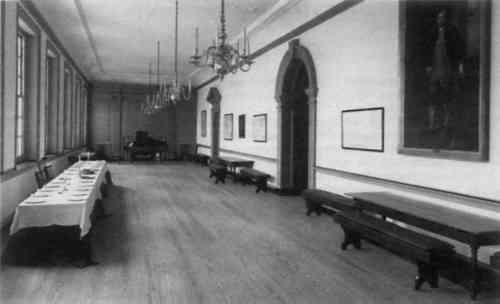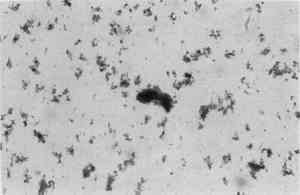PARTICLE CHARACTERISTICS OF PRUSSIAN BLUE IN AN HISTORICAL OIL PAINTFrank S. Welsh
2 LONG GALLERYTHE LONG GALLERY (Fig. 1), a second-floor room running the width of Independence Hall, was Colonial Pennsylvania's version of Versailles Palace's Hall of Mirrors. The site of 18th-century banquets and concerts, the room also served on a day-to-day basis as a reception and waiting room. The office of Pennsylvania's governor adjoined it—Independence Hall was Pennsylvania's State House—and legislators probably
During the 1950s and 1960s, the National Park Service (NPS) restoration architects found on the window sash what appeared to be the room's original blue color remaining in the grain of wood. Subsequent microscopical paint analysis on other pieces of original trim established that this medium blue-tinted oil paint was the first finish on all wood. (There are three exceptions: The baseboards and the top surfaces of the chair rails and window sills were all originally dark brown.) In the opinion of all who looked at it, the blue pigment used in this original trim color was Prussian blue. However, it was never microchemically analyzed until 1985, when Mrs. Penelope Batcheler, NPS Historical Architect, pursued further analysis of the pigment with the author. Stereo microscopical examination of a small piece of a 1730s window splayed jamb board from the Long Gallery (cat. #8428-A) confirmed Mrs. Batcheler's original finding that the first finish is ca. 1730s medium blue oil paint applied over a thin red iron oxide prime coat. Within this blue finish paint, there were large blue-black pigment agglomerates averaging 250 micrometers in diameter. Several of them were removed with a tungsten needle for further examination. One sample was mounted on a glass slide in a permanent mounting medium (Aroclor� 5442), and inspected A comparison of the unknown sample was made to known samples of natural ultramarine blue and Prussian blue. The unknown blue pigment has optical characteristics similar to both. Standard microchemical tests on the blue pigment agglomerates were carried out.1 These established that the unknown blue pigment was Prussian blue rather than natural ultramarine. Also known as Berlin blue, Paris blue, Antwerp blue, and Chinese blue, Prussian blue is the earliest modern synthetic color.2 It is a complex chemical compound, ferric ferrocyanide (Fe4(Fe[CN]6)3), first mentioned in 1710, but its preparation was kept secret until 1724. A London manufacturer named Wilkenson began production, and gradually more and more color firms followed suit. By 1750, Prussian blue must To verify the identification of Prussian blue in the Long Gallery paint, Dr. Walter C. McCrone at the McCrone Research Institute in Chicago was consulted. The paint sampled was the same first (original) 1730s finish above a red oxide primer. Stereo microscopical inspection at 70x again revealed within the film large blackish-blue pigment agglomerates. These were removed with a tungsten needle along with some of the surrounding blue paint for examination by polarized light microscopy, microchemical testing, and electron microprobe analysis. Mounted on a glass slide in Aroclor� 5442, the first Long Gallery sample revealed two pigments, a pseudo-opaque white and a blue (Fig. 2).5 The sizes of the individual anisotropic white particles generally ranged from 0.9–3.8 micrometers. Their optical properties, e.g. refractive index of ≅2.00, showed they were white lead, 2PbCo3-Pb(OH)2.6 The whole paint film itself contains close to 75%–85% of this pigment.
The blues were large isotropic glassy flakes with well-defined edges and corners and a refractive index of 1.56–1.57 as determined by dispersion staining.7 Their purple-blue color was slightly mottled, not consistently uniform. Their size generally varied from 4.0 micrometers all the way up to an incredibly large agglomerate of 46.8 micrometers. Comparison was made of the above blue particles with those of other blue pigment samples, natural ultramarine (ground lapis lazuli)8 and modern Prussian blue.9 In color and shape the Long Gallery blue pigment sample was more like the ultramarine. Like the sample, ultramarine particles are glassy, have well-defined edges and corners, and are isotropic. There, however, the similarity ended. While the Long Gallery blue color was mottled, natural ultramarine's is consistently uniform. Their respective refractive indices also are different, that of ultramarine being 1.50.10 In a comparison of the shape of the Long Gallery 18th-century blue pigment sample to the shape of the 20th century Prussian blue sample (Fig. 3),11 a distinct difference is apparent. The 18th-century pigment has sharp, well defined edges, and the 20th-century Prussian blue has rounded edges—almost amorphous in agglomerate shape. The color of the 18th-century blue is mottled, but the 20th-century Prussian blue is very dark and more uniformly blue. Both have an identical refractive index of 1.56.
When viewed at 400x magnification, the shape of the Long Gallery 18th-century blue pigment resembled natural ultramarine but could be distinguished from ultramarine by the unknown pigment's color and refractive index which strongly suggested Prussian blue. This was confirmed by standard microchemical tests.12 Electron microprobe analysis verified this identification of the blue and of the white as white lead.13 |


